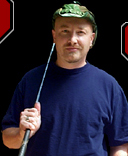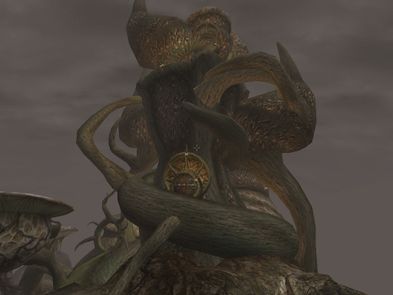This is a developer diary for The Elder Scrolls III: Morrowind. The original diary can be found here.
Mark Bullock, Artist
Hello boys and girls. My name is Mark Bullock and I am currently serving my sentence here at Bethesda as an Artist/Designer-type person. While strictly here on the Witness Protection Program, (some Federal Marshall chuckle-head handed me some Zip-disks and a pair of combat boots and told me to act like an artist.), I do have some talent to make my cover believable.
I began my career in the game industry about six years ago and completely by accident. Having recently graduated with degrees in Political Science and Criminal Justice, and a distinct lack of Third World governments to overthrow (end of the Cold War and all), I found myself sorely in need of work. I had stopped formally studying art years before, but a chance encounter with an old friend led me to a game company looking for artists.
The company, Saffire, was a small art-house staffed with a handful of very talented individuals. Perched on plastic patio furniture in a flooding basement, I became a pixel-pushing monster. Training was a voyage of self-discovery (not in the good way), and payment was piece-rate. Working on content for several titles at once was not unusual, and often times you didn't know exactly which game your current piece of art was for. You were just handed some brief parameters, a palette (sometimes) and away you went! Essentially we became Mercenary Artists, "Have brush, will travel" and all that good stuff. While there I created content for games such as "Rise of the Triad," "Monster Truck Wars," "Enemy Nations," "Hardball '95," "NFL Legends," and a host of others. Having become a master of Deluxe Animator and Deluxe Pro, most of my duties consisted of creating original tile sets and sprite animations and overseeing art teams...eventually working more towards design.
My next gig came in the form of Leaping Lizard Software. I had made contact with them while at Saffire when we had contracted with Mindscape to create art assets for the "Warhammer 40K: Dark Crusaders" title. There I began my foray into the real-time 3D game world in earnest. We produced a number of titles, including "Centipede" for the PC and Dreamcast, and "Monopoly Casino," both for Hasbro Interactive.
I came aboard the Morrowind team last August, eager and excited to work on a project with the magnitude and style Morrowind offered.
One of the first assignments I received was the design and construction of the Telvanni architectural style. Whenever I approach a design issue such as this, I prefer to examine or construct the culture, history, social morays, economics, and climatic conditions of a community (Aha! All those anthropology and history courses pay off!). You never know which bit of insight might create the key element, which pulls a design together and provides a cohesive style. Early design called for a strong organic element and I wanted to continue with this theme. Studying the existing documents and through discussions with Ken Rolston, our lead designer, I developed the basic character of the Telvanni style: Nature Derailed. The wizard-lords of House Telvanni -- being the megalomaniac, manipulative, xenophobic, power-freaks that they are -- appear instinctively disposed to the flagrant twisting and manipulation of nature. I wanted to evoke the notion of traditional ties to nature, but with the Telvanni as the masters: Zen-gardeners on a genetic bender. Therefore, sinuous, intertwined root and vines, horned growths and spikes, and a general malevolent atmosphere marked the Telvanni architectural mode.
With these notions in my mind, I created a series of simple sketches, focusing on silhouette and form. I wanted to avoid simply creating "large" plants. I brushed up on my Mycology. I drank a "tasty beverage." I looked to artists such as Barlowe, Giger, Mathews, Bosch, and Friedrich. I sat on my front porch, drinking a "tasty beverage," looking at the bushes. I pulled out my Anime. I drank more "tasty beverage."
Whenever a new tower and community was to be "built/grown," I envisioned a powerful wizard, or wizards, planting a special magic seed, dancing their dances, singing their songs, and just looking plain silly and menacing while focusing their germinating magic on the specially prepared spore. From this seed would grow the large central "trunk" which contains the main tower. From this hub, roots, feelers, tendrils, and runners would snake out, forming the basic skeleton of the supporting village or metropolis. From these would bud the pods and growths used by the general population as homes and businesses. Through this organic connection to the community, a wizard-tower could easily dominate the citizens. I imagine vengeful masters cutting off resources to certain structures, thus "killing" off a pod-house or causing a great root to burst from the surface, destroying some offensive structure.
Now that I had my "take" on the basics of a Telvanni community, I needed to go from the sketch to the model. This initially worried me, taking into account poly-counts and textures coordinates for all these organic shapes. Even the most simple of curves can add up face-counts quickly and are sometimes a nightmare to map. My savior came in the form of the "Loft."
Essentially, a loft is an extruded shape along a path. Loft parameters allow for control over the number of "Path and Shape Steps." Basically, this gives me some control over the number of sides and the number of faces along the length of the new object. These settings remain available during the deformation. The Loft also generates mapping coordinates along the length of object, making mapping the object much easier. Wheeee!! Happy day! Don't lock the doors I'm coming home loaded!
I create a line in Max, Loft a circle or other similar shape, set my mapping repeats and begin my Loft deformations and other modifiers until I achieved the shape I desired. Once I grew accustomed to the controls and could anticipate the effects of the deformations things went much smoother. Mapping was a bit difficult when applying multiple textures to the object, as was necessary for the towers, manors, and some of the root pieces. But with judicious use of the Offsets in the Material Editor, most maps could be aligned. Another bonus in using Loft was in the creation of the collision geometry. By Cloning the Lofted shape, I could go back in the "Stack" and reset the Path and Shape Steps. This way a nearly perfect, optimized mesh would result, avoiding the usual "clone and select/collapse vertices" method often used.
One of the nice things about organic forms is the fact that they can be combined into more complex shapes fairly easily because there are no obvious structures or supports, which must be aligned. The same pieces can be used in many different combinations. The greatest danger is in creating an exterior, which the interior pieces are unable to mimic. Because the interiors snap on a grid as opposed to the exterior set, I had to make a number of specific interior pieces for some of the more distinctive exterior parts. It didn't take long to find the those structures which I had created which were nearly impossible to match with an interior, (usually brought to my attention by a disgruntled designer/map builder-type person). We worked out the kinks with very little blood lost and I'm pleased with our results. Now I continue building environments and towns, confident that you will be pleased with the notorious Telvanni Towers and hope you find them as entertaining as I have. I hope I haven't bored you, many apologies if I have...and people, let's be careful out there.
Mark



